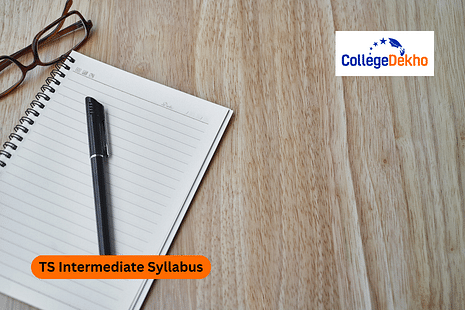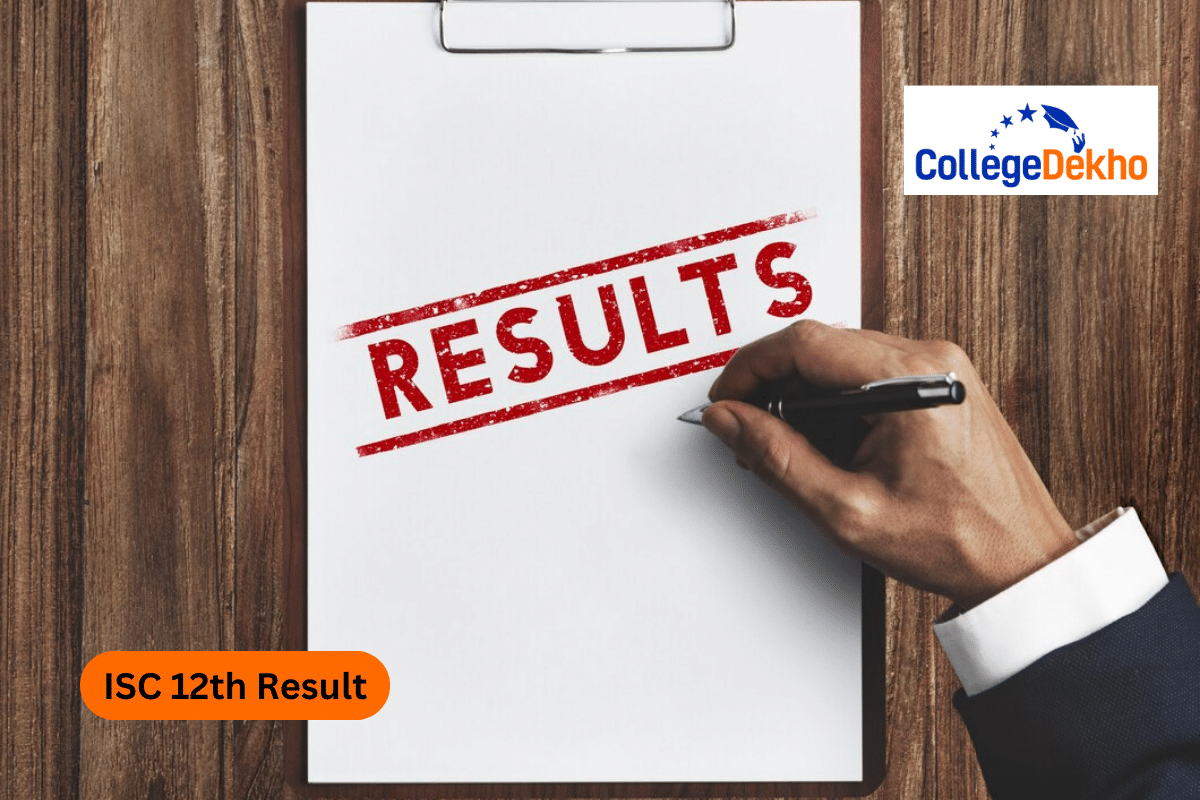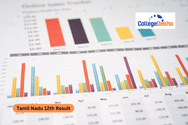TS Intermediate Syllabus 2024-25 will be uploaded on the official website of the Board of Intermediate Telangana. Students must refer to the latest PDF to prepare well for the exam.
- About TS Intermediate Syllabus 2024-25
- Latest Updates:
- TS Intermediate Syllabus 2024-25: Download PDF
- TS Intermediate Biology Syllabus 2024-25
- TS Intermediate Physics Syllabus 2024-25
- TS Intermediate Chemistry Syllabus 2024-25
- TS Intermediate Mathematics II A Syllabus 2024-25
- TS Intermediate Mathematics II B Syllabus 2024-25
- TS Intermediate English Syllabus 2024-25
- TS Intermediate Political Science Syllabus 2024-25
- TS Intermediate Economics Syllabus 2024-25
- TS Intermediate Exam Pattern 2024-25
- TS Intermediate Geography Syllabus 2024-25
- TS Intermediate History Syllabus 2024-25
- Benefits of Knowing the TS Intermediate Syllabus 2024-25
- TS Intermediate Syllabus 2024-25: Preparation Tips
- Faqs


Never Miss an Exam Update
About TS Intermediate Syllabus 2024-25
Telangana Board of Intermediate Education will release the information regarding the syllabus on the official website at tsbie.cgg.gov.in. The syllabus is one of the most important documents needed by the students to prepare for the board exam. The maximum marks allotted for each subject will be 100. Students are required to score 35 marks out of the total hundred to be qualified for the passing certificate. In some subjects, the total marks will be divided into theory and practical exams. Students must get minimum passing marks separately in both theory and practical exams to be considered as a “Pass”. Students must also check out the TS Intermediate Exam Pattern 2024-25 for better preparation.
TS Intermediate Time Table 2025 has been released on the official website. Check out more information about the TS Intermediate Syllabus 2024-25 here:
Latest Updates:
- Dec 17, 2024: Telangana State Board of Intermediate Educations release the TS Intermediate Time table 2025 for 2nd year on official website. The TS 12th Exams will be held between March 6 and March 25, 2025.
TS Intermediate Syllabus 2024-25: Download PDF
Right now, the TS Intermediate Syllabus 2024-25 has not been uploaded to the official website. Students can refer to the previous year’s syllabus PDF from the table given below since no changes are expected to be recorded in the exam pattern:
Subject Name | Download PDF |
|---|---|
Arabic | |
French | |
Hindi | |
Sanskrit | |
Telugu | |
Urdu | |
Commerce | |
Zoology |
TS Intermediate Biology Syllabus 2024-25
The biology syllabus in TS intermediate is divided into zoology and botany. Students can refer to the detailed information from the pointers given below:
Zoology | Botany |
|---|---|
Unit I A: Digestion and absorption | Chapter 1: Transport in Plants |
Unit I B: Breathing and Respiration | Chapter 2: Mineral Nutrition |
Unit II A: Body Fluids and Circulation | Chapter 3: Enzymes |
Unit II B: Excretory products and their elimination | Chapter 4: Photosynthesis in Higher Plants |
Unit III A: Muscular and Skeletal System | Chapter 5: Respiration of Plants |
Unit III B: Neural control and coordination | Chapter 6: Plant Growth and Development |
Unit IV A: Endocrine system and chemical co-ordination | Chapter 7: Bacteria |
Unit IV B: Immune system | Chapter 8: Viruses |
Unit V A: Human Reproductive System | Chapter 9: Principles of Inheritance and Variation |
Unit V B: Reproductive Health | Chapter 10: Molecular Basis of Inheritance |
Unit VI: Genetics | Chapter 11: Principles and Processes of Biotechnology |
Unit VII: Organic Evolution | Chapter 12: Biotechnology and its Applications |
Unit VIII: Applied Biology | Chapter 13: Strategies for enhancement in food production |
Chapter 14: Microbes in Human Welfare |
Also Read: TS Intermediate Biology Previous Year Question Paper
TS Intermediate Physics Syllabus 2024-25
Students can refer to the detailed information about the Physics syllabus from the table given below and prepare for the exam accordingly:
Chapters | Topics |
|---|---|
Chapter 1: Waves | Introduction Transverse and Longitudinal waves Displacement relation in a progressive wave Speed of a Travelling Wave The principle of superposition of waves Reflection of waves Beats Doppler Effect |
Chapter 2: Ray Optics And Optical Instruments | Introduction Reflection of light by Spherical Mirrors Refraction Total Internal Reflection Refraction at Spherical Surfaces and by Lenses. Refraction through a prism Dispersion by a Prism Some Natural phenomena due to Sunlight Optical Instruments |
Chapter 3: Wave Optics | Introduction Huygens Principle Refraction and Reflection of plane waves using Huygens Principle Coherent and Incoherent Addition of waves Interference of Light waves and Young’s Experiment Diffraction Polarisation |
Chapter 4: Electric Charges And Fields | Introduction Electric Charges Conductors and Insulators Charging by Induction Basic Properties of Electric Charge Coulomb’s Law Forces between Multiple charges Electric Field Electric Field Lines Electric Flux Electric Dipole Dipole in a uniform external field Continuous Charge Distribution Gauss’s Law Application of Gauss’ Law |
Chapter 5: Electrostatic Potential And Capacitance | Introduction Electrostatic Potential Potential due to a point charge Potential due to an Electric Dipole Potential due to a System of Charges Equipotential Surfaces Potential Energy of a System of Charges Potential Energy in an External field Electrostatics of Conductors Dielectrics and Polarisation Capacitors and Capacitance The Parallel Plate Capacitor Effect of Dielectric on Capacitance Combination of Capacitors Energy Stored in a Capacitor Van de Graaff Generator |
Chapter 6: Current Electricity | Introduction Electric current Electric current in conductors Ohm’s Law Drift Electrons and Origin of Resistivity Limitations of Ohm's Law Resistivity of various Materials Temperature Dependence of Resistivity Electric Energy, Power Combination of Resistors – Series and Parallel Cells, emf, Internal Resistance Cells in Series and in Parallel Kirchhoff’s Laws Wheatstone Bridge Meter Bridge Potentiometer |
Chapter 7: Moving Charges And Magnetism | Introduction Magnetic Force Motion in a Magnetic field Motion in combined Electric and Magnetic Fields Magnetic Field due to a Current Element, Biot-Savart Law Magnetic Field on the Axis of a Circular Current Loop Ampere’s Circuital Law The Solenoid and the Toroid Force between two Parallel Currents, The Ampere(Unit) Torque on Current Loop, Magnetic Dipole The Moving Coil Galvanometer |
Chapter 8: Magnetism And Matter | Introduction The Bar Magnet Magnetism and Gauss’s Law The Earth’s Magnetism Magnetisation and Magnetic Intensity Magnetic Properties of Materials Magnets and Electromagnets |
Chapter 9: Electromagnetic Induction | Introduction The experiments of Faraday and Henry Magnetic Flux Faraday’s Law of Induction Lenz’s Law and Conservation of Energy Motional Electromotive Force Energy consideration : A Quantitative Study Eddy Currents Inductance AC Generator |
Chapter 10: Alternating Current: | Introduction AC voltage applied to a Resistor Representation of AC Current and Voltage by Rotating Vectors- Phasors AC voltage applied to an Inductor AC voltage applied to a Capacitor AC voltage applied to a Series LCR Circuit Power in AC Circuit: The Power Factor LC Oscillations Transformers |
Chapter 11: Electro Magnetic Waves | Introduction Displacement Current Electro Magnetic Waves Electromagnetic Spectrum |
Chapter 12: Dual Nature Of Radiation And Matter | Introduction Electron Emission Photoelectric Effect Experimental Study of Photoelectric Effect Photoelectric Effect and Wave Theory of Light Einstein’s Photoelectric Equation: Energy Quantum of Radiation Particle Nature of Light : The Photon Wave Nature of Matter Davisson and Germer Experiment |
Chapter 13: Atoms | Introduction Alpha-particle Scattering and Rutherford’s Nuclear model of Atom Atomic Spectra Bohr Model of the Hydrogen Atom The Line Spectra of the Hydrogen Atom De Broglie’s Explanation of Bohr’s Second Postulate of Quantisation |
Chapter 14 :Nuclei | Introduction Atomic Masses and Composition of Nucleus Size of the Nucleus Mass- Energy and Nuclear Binding Energy Nuclear Force Radioactivity Nuclear Energy |
Chapter 15: Semiconductor Electronics: Materials, Devices And Simple Circuits | Introduction Classification of Metals, Conductors and Semiconductors Intrinsic Semiconductor Extrinsic Semiconductor p – n junction Semi conductor diode Application of Junction Diode as a Rectifier Special Purpose p-n Junction Diodes Junction Transistor Digital Electronics and Logic Gates Integrated Circuits |
Chapter 16: Communication Systems | Introduction Elements of communication system Basic Terminology used in Electronic Communication Systems Bandwidth of Signals Bandwidth of Transmission Medium Propagation of Electromagnetic Waves Modulation and its Necessity Amplitude Modulation Production of Amplitude Modulated Wave Detection of Amplitude Modulated Wave |
Also Read: TS Intermediate Physics Previous Year Question Paper
TS Intermediate Chemistry Syllabus 2024-25
Students can refer to the information about the Chemistry syllabus from the table given below and prepare for the exam accordingly:
Chapters | Topics |
|---|---|
Solid State | General Characteristics of Solid State Amorphous and Crystalline Solids Classification of Crystalline Solids Probing the structure of solids: X-ray crystallography Crystal Lattices and Unit Cells Number of Atoms in a Unit Cell Close Packed Structures Packing Efficiency Calculations Involving Unit Cell Dimensions Imperfections in Solids Electrical Properties Magnetic Properties |
Solutions | Types of Solutions Expressing Concentration of Solutions Solubility Vapour Pressure of Liquid Solutions Ideal and Non-ideal Solutions Colligative Properties and Determination of Molar Mass Abnormal Molar Masses |
Electrochemistry And Chemical Kinetics | Electrochemical Cells Galvanic Cells Nernst Equation Conductance of Electrolytic Solutions Electrolytic Cells and Electrolysis Batteries Fuel Cells Corrosion Rate of a Chemical Reaction Factors Influencing Rate of a Reaction Integrated Rate Equations Pseudo First Order Reaction Temperature Dependence of the Rate of a Reaction Collision Theory of Chemical Reaction Rates |
Surface Chemistry | Adsorption Catalysis Colloids Classification of Colloids Emulsions Colloids Around Us |
General Principles Of Metallurgy | Occurrence of Metals Concentration of Ores Extraction of Crude Metal from Concentrated Ore Thermodynamic Principles of Metallurgy Electrochemical Principles of Metallurgy Oxidation and Reduction Refining of Crude Metal Uses of Aluminium, Copper, Zinc and Iron |
P-Block Elements | Introduction Dinitrogen Ammonia Oxides of nitrogen Nitric acid Phosphorous-allotropic forms Phosphine Phosphorous halides Oxoacids of phosphorous Introduction Dioxygen Simple Oxides Ozone Sulphur-Allotropic forms Sulphur dioxide Oxoacids of Sulphur Sulphuric Acid Introduction Chlorine Hydrogen Chloride Oxoacids of Halogens Interhalogen Compounds Introduction- Occurance, Electronic configuration Ionisation Enthalpy,Atomic radii, Electron Gain Enthalpy Physical and Chemical properties |
D And F Block Elements & Coordination Compounds | Position in the Periodic Table Electronic Configuration General Properties of Transition Elements (dBlock) Some Important Compounds of Transition Elements Inner Transition Elements(f-Block) Actinoids Some Applications of d and f Block Elements Werner’s Theory of Coordination Compounds Definitions of Some Terms used in Coordination Compounds Nomenclature of Coordination Compounds Isomerism in Coordination Compounds Bonding in Coordination Compounds Bonding in Metal Carbonyls Stability of Coordination Compounds Importance and Applications of Coordination Compounds |
Polymers | Classification of Polymers Types of Polymerization Reactions Molecular Mass of Polymers Biodegradable Polymers Polymers of Commercial Importance |
Biomolecules | Carbohydrates Proteins Enzymes Vitamins Nucleic acids Hormones |
Chemistry In Everyday Life | Drugs and their Classification Drug-Target Interaction Therapeutic Action of Different Classes of Drugs Chemicals in Food Cleansing Agents |
Halo Alkanes And Haloarenes | Classification Nature of C-X bond Methods of Preparation Physical Properties Chemical Reactions Polyhalogen Compounds |
Organic Compounds Containing C, H And O (Alcohols, Phenols, Ethers, Aldehydes, Ketones And Carboxylic Acids) Alcohols, Phenols, Ethers | Classification -Alcohols, Phenols and Ethers Nomenclature- Alcohols, Phenols and Ethers Structures of Hydroxy and Ether Functional Groups Alcohols and Phenols Physical Properties Chemical Reactions Some Commercially Important Alcohols Ethers Nomenclature and Structure of Carbonyl Group Preparation of Aldehydes and ketones Physical Properties Chemical Reactions Uses of Aldehydes and Ketones Nomenclature and Structure of Carboxyl Group Methods of Preparation of Carboxylic Acids Physical Properties Chemical Reactions Uses of Carboxylic Acids |
Organic Compounds Containing Nitrogen | Structure of Amines Classification Nomenclature Preparation of Amines Physical Properties Chemical Reactions Methods of Preparation of Diazonium Salts Physical Properties Chemical Reactions Importance of Diazonium Salts in Synthesis of Aromatic Compounds Structure of cyanides and isocyanides Preparation |
Also Read: TS Intermediate Chemistry Previous Year Question Paper
TS Intermediate Mathematics II A Syllabus 2024-25
Students can refer to the Mathematics syllabus from the table given below and use it to prepare effectively for the board exams:
Chapters | Topics |
|---|---|
Theory of Equations | The relation between the roots and coefficients in an equation Solving the equations when two or more roots of it are connected by certain relation Equation with real coefficients, occurrence of complex roots in conjugate pairs and its consequences Transformation of equations - Reciprocal Equations. |
Measures Of Dispersion | Range Mean deviation Variance and standard deviation of ungrouped/grouped data. Coefficient of variation and analysis of frequency distribution with equal means but different variances. |
Random Variables and Probability Distributions | Random Variables Theoretical discrete distributions – Binomial and Poisson Distributions |
Probability | Random experiments and events Classical definition of probability, Axiomatic approach and addition theorem of probability. Independent and dependent events Conditional probability- multiplication theorem andBayee’s theorem. |
Quadratic Expressions | Quadratic expressions, equations in one variable Sign of quadratic expressions – Change in signs – Maximum and minimum values Quadratic inequations |
Partial fractions | Partial fractions of f(x)/g(x) when g(x) contains non –repeated linear factors Partial fractions of f(x)/g(x) when g(x) contains repeated and/or non-repeatedlinear factors. Partial fractions of f(x)/g(x) when g(x) contains repeated and non-repeated irreducible factors only |
Permutations and Combinations | Fundamental Principle of counting – linear and circular permutations Permutations of ‘n’ dissimilar things taken ‘r’ at a time Permutations when repetitions allowed Circular permutations Permutations with constraint repetitions Combinations-definitions and certain theorems |
De Moivre’s Theorem | De Moivre’s theorem- Integral and Rational indices. nth roots of unity- Geometrical Interpretations – Illustrations. |
Complex Numbers | Complex number as an ordered pair of real numbers- fundamental operations Representation of complex numbers in the form a+ib. Modulus and amplitude of complex numbers –Illustrations. Geometrical and Polar Representation of complex numbers in Argand planeArgand diagram |
Binomial Theorem | Binomial theorem for positive integral index Binomial theorem for rational Index (Without proof) Approximations using Binomial theorem |
Also Read: TS Intermediate Mathematics Previous Year Question Paper
TS Intermediate Mathematics II B Syllabus 2024-25
Students can check out the detailed information about the Mathematics B syllabus from the table given below to effectively prepare for the exam:
Chapters | Topics |
|---|---|
Integration | Integration as the inverse process of differentiation- Standard forms –properties of integrals. Method of substitution- integration of Algebraic, exponential, logarithmic, trigonometric and inverse trigonometric functions. Integration by parts. Integration- Partial fractions method. Reduction formulae |
Differential equations | Formation of differential equation-Degree and order of an ordinary differential equation. Solving differential equation by a) Variables separable method b) Homogeneous differential equation. c) Non - Homogeneous differential equation. d) Linear differential equations. |
Hyperbola | Equation of hyperbola in standard form- Parametric equations. Equations of tangent and normal at a point on the hyperbola (Cartesian and parametric)- conditions for a straight line to be a tangent- Asymptotes |
Ellipse | Equation of ellipse in standard form- Parametric equations. Equation of tangent and normal at a point on the ellipse (Cartesian and parametric)- Condition for a straight line to be a tangent. |
Circle | Equation of circle -standard form-centre and radius of a circle with a given line segment as diameter & equation of circle through three non collinear points -parametric equations of a circle. Position of a point in the plane of a circle – power of a point-definition of tangent-length of tangent Position of a straight line in the plane of a circle-conditions for a line to be tangent – chord joining two points on a circle – equation of the tangent at a point on the circle- point of contact-equation of normal. Chord of contact - pole and polar-conjugate points and conjugate lines - equation of chord with given middle point. Relative position of two circles- circles touching each other externally, internally common tangents –centers of similitude-equation of pair of tangents from an external point. |
Definite Integrals | Definite Integral as the limit of sum Interpretation of Definite Integral as an area. Fundamental theorem of Integral Calculus. Properties Reduction formulae. Application of Definite integral to areas. |
Parabola | Conic sections –Parabola- equation of parabola in standard form-different forms of parabola- parametric equations. Equations of tangent and normal at a point on the parabola ( Cartesian and parametric)- conditions for straight line to be a tangent. |
System of circles | Angle between two intersecting circles. Radical axis of two circles- properties- Common chord and common tangent of two circles – radicalcentre. |
TS Intermediate English Syllabus 2024-25
Students can check out the detailed information about the chapters that will be included in the English syllabus from the table given below:
Particulars | Details |
|---|---|
Prose | Playing the English Gentleman - M.K. Gandhi The Bet - Anton Chekov The Mad Tea Party - Lewis Carrol On Smiles - A.G. Gardiner The Prize Poem Sir P. G. Wodehouse Sale - Anita Desai Riders to the Sea - J.M. Synge |
Poetry | Ulysses - Alfred Lord Tennyson The Second Coming - W.B. Yeats The Unknown Citizen - W.H. Auden To the Indians who Died in South Africa -T.S. Eliot The Night of the Scorpion - Nissim Ezekiel Rakhi - Vikram Seth Telephone Conversation - Wole Soyinka |
Non-detailed Text | Julius Caesar - Shakespeare Orient Longman Edition |
Also Read: TS Intermediate English Previous Year Question Paper
TS Intermediate Political Science Syllabus 2024-25
If you have chosen Arts stream in intermediate, you can refer to the syllabus for the same from the table given below:
Chapters | Topics |
|---|---|
Chapter I. Indian Constitution - Historical Content | Indian National Movement; Phases of National Movement The Government of India Acts 1909, 1919, 1935 Constituent Assembly and framing of Indian Constitution Philosophy and basic features of Constitution |
Chapter II. Fundamental Rights & Directive Principles of State Policy | Fundamental Rights Directive Principles of State Policy Fundamental Duties |
Chapter III. Union Government | The President of India The Vice-President of India The Prime Minister of India Union Council of Ministers Parliament of India Supreme Court |
Chapter IV. State Government | Governor Chief Minister Council of Ministers in the state Legislative: Legislative Assembly Legislative Council High Court |
Chapter V Centre State Relations | Centre – State Legislative, Administrative, Financial Relations Centre-State Conflicts: Sarkaria Commission, M.M.Punchhi Commission Centre Finance Commission Inter – State Council NITI Aayog |
Chapter VI. Local Governments | Rural Development & Panchayat Raj Institutions Grassroot democracy: 73rd Amendment 74th Amendment Panchayat Raj and Urban Local bodies in Telangana |
Chapter VII. Election System in India | Central Election Commission Powers and functions of the Election Commission Electoral Reforms in India Political Parties in India Anti Defection Law |
Chapter VIII. Contemporary Issues in Indian Politics | Dynamic nature of Indian Politics Regionalism Coalition Politics Corruption Terrorism |
Chapter IX: Emergence of Telangana State | Formation of Hyderabad State Political development Gentlemen Agreement Emergency of Andhra Pradesh Violation of Safeguards 1969 Agitation – Telangana Praja Samithi Reaction of Mulki Judgment Telangana Movement Role of JAC’s in Telangana Movement A.P. Reorganisation Act, formation of Telangana state |
Chapter X: SMART Governance | SMART Governance Good Governance E-Governance Right to Information Act Lokpal, Lokayutha Act - 2013 Transparency and Accountability |
Chapter XI: India and the World | Determinants of Foreign Policy Basic Features of India’s Foreign Policy India and Non-Aligned Movement India and BRICS India and BIMSTEC SAARC UNO |
TS Intermediate Economics Syllabus 2024-25
For Economics, students can refer to the following syllabus when appearing for the board exams:
Unit | Topics |
|---|---|
Unit 1: Economic Growth and Economic Development | Concepts of Economic Growth and Economic Development Objectives of Economic Development Indicators of Economic Development Factors Hindering Economic Development Factors Promoting Economic Development Characteristics of Developed Economies Characteristics of Developing Economies with Special Reference to India |
Unit 2: Demography and Human Resource Development | Theory of Demographic Transition Demographic Features of Indian Population Concept and Causes of Population Explosion Occupational and Sectoral Distribution of Population in India Population Policy in India Human Resource Development: Concept and Importance Role of Education in Economic Development and Education in India Role of Health in Economic Development and Health in India Human Development Index Views of Amartya Sen on Human Development |
Unit 3: National Income, Poverty and Unemployment | A Backdrop to National Income Studies Changes in National Income and Per Capita Income in India Sectoral Contribution to National Income Share of Public Sector and Private Sector in GDP Inequalities in the Distribution of Income and Wealth: Causes and Remedial Measures Poverty in India: Concept, Types, Incidence, Causes and Consequences Unemployment in India: Types, Concepts, Estimates, Causes and Consequences Remedial Measures of Poverty & Unemployment - Government Initiatives Views of Abhijit Banerjee on Poverty |
Unit No.4: Planning and NITI Aayog | Concept, Types and Importance of Planning Major Objectives of Five Year Plans in India Review of Five Year Plans NITI Aayog Rural - Urban Imbalances Regional Imbalances: Causes, Consequences & Remedial Measures |
Unit 5:Agricultural Sector | Importance and Growth of Agriculture in Indian Economy Causes for Low Productivity in Agriculture and Measures to Improve Agricultural Productivity in India Land Reforms in India Green Revolution Agricultural Credit and Rural Indebtedness Agricultural Marketing in India Agricultural Pricing Policy in India Food Security |
Unit 6: Industrial Sector | Structure of Indian Industry Growth and Pattern of Industrial Development in India Industrial Backwardness Industrial Policy Resolutions Economic Reforms Demonetization Goods and Services Tax Make in India Economic Reforms and Industrial Growth Small Scale Industries: Characteristics, Role, Problems and Remedial Measures Industrial Finance |
Unit 7: Tertiary Sector | Importance of Tertiary Sector Growth of Service Sector in India Sector Performance at the State and UT Level Performance of India's Key Sub-Sectors of Services Tourism Sector IT-BPM Services Infrastructure Transport Sector Energy Sector Telecom Sector Banking Sector Insurance Sector Space Sector |
Unit 8: Foreign Sector | Balance of Trade Vs Balance of Payments Balance of Trade and Balance of Payments with Special Reference to India Role of International Trade in Indian Economy Foreign Direct Investment (FDI) Objectives and Functions of General Agreement on Tariffs and Trade (GATT) Objectives and Functions of World Trade Organization (WTO) Impact of WTO on Indian Economy |
Unit 9: Environmental Economics | Concept, Types and Importance of Environment in Economic Development Concepts of Eco-System, Pollution and Environmental Degradation Natural Resources Need for Environmental Protection Sustainable Development |
Unit 10: Telangana Economy | Structure of Telangana State Gross State Domestic Product (GSDP) Per Capita Income at Current Prices in Telangana Demographic Features of Telangana Agricultural Sector in Telangana Industrial Sector in Telangana Services Sector in Telangana Development in Telangana Infrastructural Development in Telangana Poverty and Unemployment in Telangana Development and Welfare Programmes in Telangana State |
Also Read: TS Intermediate Economics Previous Year Question Paper
TS Intermediate Exam Pattern 2024-25
The subject-wise exam pattern and marks distribution for the Telangana class 12 exam have been given below:
Subjects | Maximum marks |
|---|---|
English, optional languages (viz., Telugu, Hindi, Sanskrit, Urdu, Arabic, French, Tamil, Kannada, Oriya, Marathi), Commerce, Economics, Civics, History, Geology, Home Science, Logic, Public Administration, Sociology, and Psychology. | 100 |
Mathematics and Geography | 75 |
Physics, Chemistry, Botany, and Zoology | 60 |
Music | 50 |
TS Intermediate Geography Syllabus 2024-25
Students can refer to the detailed information about the Geography syllabus from the table given below and prepare for the exam accordingly:
Chapters | Topics |
|---|---|
Human Geography | Meaning, Nature, scope, and relevance of Human Geography; Man - Environment relationships; Branches of Human Geography - their general characteristics |
World Population | Distribution, density of population, Growth of population in the world. Composition of population: Age and Sex. Factors affecting/influencing the distribution of population, Migration: Internal and international; Causes and consequences Human Development: concepts, Indicators and world patterns |
Economic Geography | Economic Geography: Definition, Scope, and Significance; Sectors of Economic activity: Concepts, changing trends. Primary Activities: Concepts, changing trends. Food gathering, pastoral, mining, and subsistence agriculture. Modern Agriculture, people engaged in agricultural and allied activities. Fisheries - factors and important fishing grounds; agriculture regions of the world. Secondary Activities: Concepts. Manufacturing industries: Locational factors, types - distribution and production - Agro-based: Textile (cotton), forest-based (paper), Mineral-based (Iron and steel): Petrochemical. Small scale manufacturing industries: locational factors, distribution, and production. People engaged in secondary activities examples Tertiary Economic activities: Concepts, Trade, Transport, and Tourism; services, people engaged in the tertiary activities with some examples Quarternry Economic activities: Concepts, people engaged in the quaternary with some examples. |
World Transport and Trade | Relative significance of different means of transport - Land transport, Railways - transcontinental Railways, Airways and Waterways. Factors affecting land, water, and air transport; World oceanic routes; important inland waterways and important canals; International trade - Impact of globalization and economic development. Role of WTO in International trade (World Trade Organization) |
Environment and Resources | Resources: Definition, Classification - Resource depletion Environment: Meaning, definition, and components; Environmental conservation and management; sustainable development |
Human Settlements Settlement | Settlement types - rural and urban; urbanization trends and consequences |
Physiography | Locational characteristics; Physical setting; Physiographic divisions; Geology, Drainage system: The Himalayan and Peninsular System |
Climate | Origin of monsoon, climatic regions in India; distribution of temperature and Rainfall Soils: Types and distribution, characteristics; Soil degradation and conservation Vegetation: Types and distribution Wildlife conservation, Biosphere reserves |
Population | Population: Size, Growth, Distribution, and Density from 1901-2011; demographic characteristics: literacy, sex ratio; regional variations in population growth, Trends of Urbanization, population problems. Migration: International, National, causes and consequences. Human Development: Introduction and Regional Pattern |
Resources | Mineral and Energy Resource Base: distribution and production Minerals - Iron ore, Manganese, and Bauxite; Power resources - Coal, Petroleum and natural gas, hydroelectric power; Non - conventional sources of energy (Solar, Wind and Biogas), Conservation of Resources. |
Land Resources | Agriculture : General Land Use, Land Use Classification Distribution and production of Major Crops - wheat, rice, sugarcane, cotton, caster and ground nut, Coffee and tea - their distribution, production, and trade; Impacts of Green revolution on Indian agriculture; Problems of Indian agriculture. Land Degradation |
Water Resources | Irrigation and Power: Types of Irrigation, Wells, canals, and tanks Major multipurpose projects: Bakra Nangal, Nagarjuna Sagar, Narmada and Damodar Valley Corporation. Rain Water Harvesting and Watershed Management. |
Industries | Location factors, growth, distribution, and trade Iron and Steel, Petro Chemicals, Pharmaceuticals, and Knowledge-based industries (IT), Globalization and Economic Development, SEZs |
Transport and Trade | Means of transport; roadways, railways, airways, and waterways, Major ports of India’s International trade. |
Telangana | Administrative regions; physiography, Geology, Drainage |
Climate | Distribution of climate, temperature, and rainfall. Soils: Types and distribution, characteristics; Soil degradation and conservation Vegetation: Types and distribution |
Population | Size, Growth, Distribution and Density from 1961-2011; demographic characteristics: literacy, sex ratio; Rural and Urban populations. |
TS Intermediate History Syllabus 2024-25
If you have chosen the Arts stream, you can check out the detailed information about the history syllabus from the table given below:
Unit | Topics |
|---|---|
Unit-I Geographical Sources Pre History: | Geographical features of Telangana - Pre and Proto a).History Literary Source: b). Archeological Sources: Pre History of Telangana Asmaka Janapada Assignment -I Assignment -II |
Unit-II Age of Satavahanas: Source – Brief Political History | Gautamiputra Satakarni, Yagna Sri Satakarmi - Polity & Administrative System - Socieo - Economic conditions - Trade and Commerce - Language, Literature, Art and Architecture |
Unit –III Post Satavahana Period: | Ikshavakus and Vishnukundins and their contributions, Kalyani Chalukyas, Mudigonda and Vemulavada Chalukyasmudiganda Chalukyas Rastrakutas and Vakatakas Kanduri Chodos Brief Political History |
Unit –IV Age of Kakatiyas: | Sources Brief Political Histories Kakatiya dynasty - Rudradeva, Ganapathideva, Rudramadevi, Pratapa Rudra, Polity, Administrative System - Socio-economic conditions-agriculture and irrigation - Growth of Telugu Literture, Art and architecture Post Kakatiya Period: Musunuri and Recharla Rules |
Unit – V Qutub Shahis | Important Rulers - Ibrahim Qutub Shah, Mohd Quli Qutb Shah - Polity and Administrative System, Trade and Commerce - Agriculture and Irrigation Development, Contribution to Telugu Literature, Art and architecture Mughal Rule in Telangana popular Residence SarvaiPapanna. |
Unit – VI Asaf Jahis | Introduction- Foundation of Asaf Jahi Nizam-Mul-Mulk Asafjah-Nizam Ali Khan, Mir Mahabub Ali Khan, Mir Osman Ali Khan, Salarjung Reforms. Moderation of Hyderabad under last Nizams Growth of Industries Transportation and Communication Education and Health |
Unit - VII Socio- Cultural and Policital awakening in Telangana | IntroductionDevelopment of Modern Education awakening Growth of Pree (in Brief) Library Movement – chanda Railway Scheme – Viveka vardhini incidental Formation of Nizam Andhra Mahasabha – its Activities and Conferences Details – Andhra Mahila Sabha Aryasamaj and its activities – Wahabi movement. Dalit movements – Bhagya Reddy Varma |
Unit-VIII : Tribal and Peasant Movements in Telangana | Introduction: Land Revenue systems in Nizam State Tribal Movements. Ramji Gond Komuram Bheem Muslim Ittehadul Muslimin-ulparty – Razakars – Telangana Peasant Armed Struggle – causes and results. |
Unit IX : Freedom Movement in Hyderabad State | Introducation – Growth of Nationalism in Hyderabad – 1857 Revolt – Turrebaz Khan – 1938 Vandamatram Movement in Osmania University – Hyderabad State Congress – its Prominent leaders – its activities – Join India Movement Police Action. |
Unit X : Separate Telangana State Movement – Early Phase: | Introduction – Formation of Hyderabad state Brurguda Rama Krishna Rao – Demanel for vishalandhra - Assertion of Mulki Identity and the city college Incident (1952) – Fazul Ali Commission (SRC) – Gentleman’s agreement – Formation of Andhra Pradesh – Discrimination Dissent and Protest – violation of Gentlemen’s Agreement – Agitation for separate Telangana State Formation of TPS – Role of Intellectuals Students Employees in 1969 Movement. |
Unit - XI: SeparteTelangana State Movement Later Phase | Introduction Second Phase Movement for separate Telangana – Formation of Various Associations – TelanganaAikyaVedika – Telangana Jana Sabha Telangana Rashtra Samiti (2001) – Mass Mobilization TJAC – Sakala Janula Samme – Millenniun March – Sagara Haram – Chalo Assembly – December 2009 Declaration and the Formation of Telangana State June-2024 |
Unit- XII: Fairs and Festivals of Telangana | Introduction: Fairs of Telangana with special reference to Sammakka Sarakka Edupayalu Nagoba Jathara- Gollagattu Jathara Kurumurthy. Festivals of Telangana with special reference to Bonalu – Bathukamma – Muharram - Teez |
Also Read: TS Intermediate History Previous Year Question Paper
Benefits of Knowing the TS Intermediate Syllabus 2024-25
Checking the latest syllabus must be the first step in the preparations for the board exams. Some benefits of learning about the syllabus are:
- The syllabus will help the students to plan out their studies for the exams.
- Students can easily check the amount of weightage allotted for each unit included in the curriculum by using the TS Intermediate Syllabus 2024-25.
- Students can identify important topics and complete them first through the syllabus.
- Through the syllabus, students can track their progress.
- The syllabus will also help the students to understand the omissions made in the curriculum by the Telangana Board of Intermediate Education.
TS Intermediate Syllabus 2024-25: Preparation Tips
Students can refer to some important Telangana Intermediate Preparation Tips 2025 here:
- Download the latest syllabus and exam pattern as soon as available on the official website of the Telangana Board of Intermediate Education. Students can check the information about the deleted topics and changes in the exam pattern only if they download the latest syllabus.
- Check out the model test papers and old Telangana Class 12 Question Paper to catch the commonly asked questions and the paper pattern.
- Try to divide your syllabus into small study sessions so that you do not feel lethargic after one study session alone. Focus on creating healthy habits leading up to your exam.
- Complete the syllabus as soon as possible so that you can focus on revision once there is not enough time left for your exam. Make sure to evaluate your results based on the marks that you are achieving in model papers.
- Focus on keeping your mind calm during your board exams. Make sure to get rid of bad habits and focus on creating good habits. Try to meditate and do yoga in your free time.
FAQs
When studying TS Intermediate Syllabus 2024-25, students can divide the syllabus into smaller units. This will make it easier for students to cover up the entire syllabus.
Students can visit the official website of the TGBIE to download the latest TS Intermediate Syllabus 2024-25 available in PDF format. For each of the subjects, the previous year's question papers are also available online.
Students should aim to complete the entire TS Intermediate Syllabus 2024-25 at least a month before the exam. This will provide them with a good opportunity to revise.
To score above 90%, it requires consistent study and hard work. Completing the entire TS Intermediate Syllabus 2024-25 and scoring high marks can become difficult for students in one month.
Was this article helpful?
















